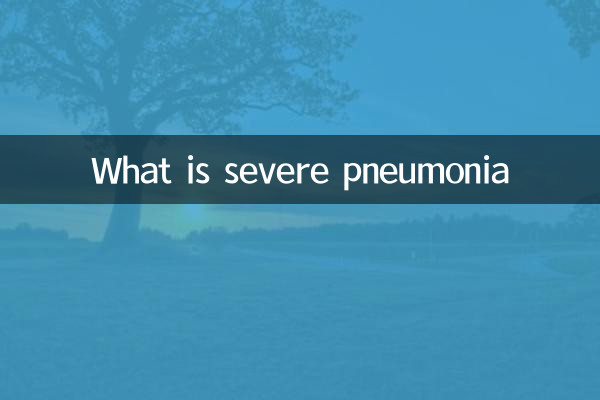What is severe pneumonia
Severe pneumonia is a severe lung infection usually caused by bacteria, viruses or fungi that can lead to respiratory failure, multiple organ failure and even death. In recent years, with global climate change and pathogen mutation, the incidence of severe pneumonia has increased, becoming one of the health hotspots of public concern. This article will combine recent hot topics and structured data to analyze in detail the definition, symptoms, high-risk groups and prevention and treatment measures of severe pneumonia.
1. Definition and causes of severe pneumonia

Severe pneumonia refers to pneumonia patients who develop severe respiratory dysfunction or systemic inflammatory response and need to be admitted to ICU or receive mechanical ventilation treatment. According to the World Health Organization (WHO), pneumonia is one of the leading causes of death among children and the elderly worldwide. The following is the distribution of common pathogens:
| Pathogen type | Proportion (adult cases) | Common subtypes |
|---|---|---|
| bacteria | 50%-60% | Streptococcus pneumoniae, Staphylococcus aureus |
| Virus | 30%-40% | Influenza virus, new coronavirus |
| Fungus | 5%-10% | Aspergillus, Pneumocystis |
2. Recent hot-related events
In the past 10 days, the following events have triggered widespread public discussion about pneumonia:
| date | event | associated pathogens |
|---|---|---|
| 2023-11-15 | Multiple provinces in northern China report clusters of childhood pneumonia cases | Mycoplasma pneumoniae |
| 2023-11-18 | WHO issues global antibiotic-resistant pneumonia alert | MRSA (methicillin-resistant Staphylococcus aureus) |
| 2023-11-20 | CDC updates guidance on pneumonia complications during flu season | H3N2 influenza virus |
3. Typical symptoms and diagnostic criteria
Clinical manifestations of severe pneumonia include:
| Symptom Category | Specific performance | Hazard classification |
|---|---|---|
| respiratory system | Respiratory rate >30 times/min, blood oxygen saturation <90% | high risk |
| circulatory system | Systolic blood pressure <90mmHg, requiring vasoactive drugs | Very high risk |
| nervous system | Confusion, disorientation | critical |
4. Prevention and control measures and latest developments
According to the recommendations of the health departments of various countries in November 2023:
| Precautions | Applicable people | efficient |
|---|---|---|
| 13-valent pneumococcal vaccine | Seniors over 65 years old | 75%-85% |
| Oseltamivir antiviral treatment | influenza-associated pneumonia | Early use can reduce the rate of severe illness by 60% |
| ECMO (extracorporeal membrane oxygenation) | refractory respiratory failure | Survival rate is about 50%-70% |
5. Recommendations for protection of key groups of people
1.children group: Recently, many countries have reported a surge in Mycoplasma pneumoniae infections. It is recommended to avoid going to crowded places and seek medical treatment in time if fever persists for more than 3 days.
2.Chronic disease patients: Patients with COPD and diabetes should be given priority to receive influenza vaccine and pneumonia vaccine.
3.medical staff: Strictly implement N95 mask wearing and hand hygiene when coming into contact with patients with respiratory infections.
Current monitoring data shows that the northern hemisphere is about to enter a season of high incidence of respiratory infectious diseases, and the public needs to be alert to the possibility of common pneumonia developing into severe disease. When warning symptoms such as shortness of breath, persistent high fever, or changes in consciousness occur, you should immediately go to a medical institution with severe treatment capabilities.

check the details

check the details